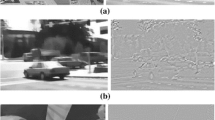Abstract
A well-known method for the reconstruction of motion fields from noisy image data is to determine flow fields by the minimization of a quadratic functional. The first approach of this class has been proposed by Horn and Schunck (1981). A drawback of such approaches is that an explicit representation of the discontinuities of the motion field is lacking and that, in general, the resulting flow fields approximate the motion fields only badly at the corresponding locations in the image plane. In this article, we discuss the possibility to improve the results by hypothesizing the qualitative structure of the motion field in terms of certain parameters. We decompose the image plane into disjoint sets, restrict the domain of definition of the functionals to these sets, and use the hypotheses to deform and to move the boundaries of the sets within the image plane. We discuss the range of applicability of this new technique and illustrate the algorithm by numerical examples. This article is a revised and extended version of Schnörr (1990).
Similar content being viewed by others
References
Blake, A. and Zisserman, A., 1987. Visual Reconstruction. MIT Press, Cambridge, MA.
Geman, S., and Geman, D., 1984. Stochastic relaxation, Gibbs distributions, and the Bayesian restoration of images, IEEE Trans. Patt. Anal. Mach. Intell. 6(6): 721–741.
Haug, E., and Cea, J., (eds.), 1981. Optimization of distributed parameter structures—Vol. 2. Sijthoff+Noordhoff, Alphen aan den Rijn: The Netherlands and Rockville, Maryland, USA.
Horn, B.K.P., and Schunck, B.G., 1981. Determining optical flow. Artificial Intelligence 17: 185–203.
Hutchinson, J., Koch, C., Luo, J., and Mead, C., 1988. Computing motion using analog and binary resistive networks, IEEE Computer 21: 52–63.
Lions, J.-L., 1971. Optimal control of systems governed by partial differential equations. Springer-Verlag: Berlin, Heidelberg, New York.
Murat, F., and Simon, J., 1976. Etude de problemes d'optimal design. Optimization Techniques. Proc. 7th IFIP Conf. Nice, Sept. 8–12, 1975, in J.Cea (ed.), Lect. Notes Comput. Sci. 41, Springer-Verlag: Berlin, Heidelberg, New York.
Murray, D.W., and Buxton, B.F., 1987. Scene segmentation from visual motion using global optimization, IEEE Trans. Patt. Anal. Mach. Intell. 9(2): 220–228.
Nagel, H.-H., 1987. On the estimation of optical flow: relations between different approaches and some new results. Artificial Intelligence 33: 299–324.
Nagel, H.-H., 1989. On a constraint equation for the estimation of displacement rates in image sequences. IEEE Trans. Patt. Anal. Mach. Intell. 11 (1): 13–30.
Pironneau, O., 1983 Optimal shape design for elliptic systems. Springer-Verlag: New York, Berlin, Heidelberg, Tokyo.
Schnörr, C., 1990. Computation of discontinuous optical flow by domain decomposition and shape optimization, Brit. Mach. Vis. Conf., Oxford/UK, 24.-27.09.1990, pp. 109–114.
Schnörr, C., 1991a. Determining optical flow for irregular domains by minimizing quadratic functionals of a certain class. Intern. J. Comput. Vis. 6(1): 25–38.
Schnörr, C., 1991b. Funktionalanalytische Methoden zur Gewinnung von Bewegungsinformation aus TV-Bildfolgen. Dissertation, Universität Karlsruhe (TH), Fakultät für Informatik.
Simon, J., 1980. Differentiation with respect to the domain in boundary value problems. Numer. Funct. Anal. Optimiz. 2(7&8):649–687.
Terzopoulos, D., 1988. The computation of visible-surface representations. IEEE Trans. Patt. Anal. Mach. Intell. 10(4):417–438.
Verri, A., and Poggio, T., 1987. Against quantitative optical flow Proc. 1st Intern. Conf. Comput. Vis. June 8–11, London, pp. 171–180.
Yuille, A.L., Geiger, D., and Bülthoff, H., 1990. Stereo integration, mean field theory and psychophysics. 1st Europ. Conf. Comput. Vis., Antibes, France, April 23–27, O. Faugeras (ed.), Lect. Notes Comput. Sci. 427, Springer-Verlag, pp. 73–82.
Author information
Authors and Affiliations
Additional information
This work has been supported by the PROMETHEUS programme while the author was with the Fraunhofer-Institut (IITB) at Karlsruhe.
Rights and permissions
About this article
Cite this article
Schnörr, C. Computation of discontinuous optical flow by domain decomposition and shape optimization. Int J Comput Vision 8, 153–165 (1992). https://doi.org/10.1007/BF00127172
Received:
Issue Date:
DOI: https://doi.org/10.1007/BF00127172




